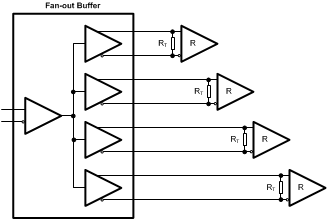SNLA113C november 2008 – june 2023 DS91M124 , DS91M125 , SN65LVDM050 , SN65LVDM050-Q1 , SN65LVDM051 , SN65LVDM051-Q1 , SN65LVDM1676 , SN65LVDM1677 , SN65LVDM176 , SN65LVDM179 , SN65LVDM180 , SN65LVDM22 , SN65LVDM31 , SN65MLVD040 , SN65MLVD047A , SN65MLVD048 , SN65MLVD080 , SN65MLVD082 , SN65MLVD128 , SN65MLVD129 , SN65MLVD2 , SN65MLVD200A , SN65MLVD202A , SN65MLVD204A , SN65MLVD204B , SN65MLVD206B , SN65MLVD3
- 1
- AN-1926 An Introduction to M-LVDS and Clock and Data Distribution Applications
- Trademarks
- 1 Introduction
- 2 M-LVDS Standard Overview
- 3 Driver Characteristics
- 4 Receiver Characteristics
- 5 M-LVDS Portfolio
- 6 M-LVDS Applications
- 7 Clock Distribution in AdvancedTCA Systems
- 8 Clock Distribution in MicroTCA Systems
- 9 M-LVDS as a Short Reach RS-485 Alternative
- 10Signal Distribution with Point-to-Point Links
- 11Wired-OR Implementation
- 12Design Guidelines
- 13Conclusion
- 14References
- 15Revision History
10 Signal Distribution with Point-to-Point Links
Among many other benefits, signal distribution with multipoint networks reduces connector size and cable diameter, lowers conductor count and PCB thickness, and ultimately decreases system cost. These benefits come at the cost of signal integrity, maximum transmission reach and speed. When satisfactory signal integrity, transmission reach or speed using multipoint networks cannot be achieved, signal distribution with point-to-point links may be the only option. Signal distribution with point-to-point links is accomplished using fan-out buffers as illustrated in Figure 10-1.
 Figure 10-1 Signal Distribution with Point-to-Point Links
Figure 10-1 Signal Distribution with Point-to-Point LinksThe current M-LVDS portfolio offers two 1:4 fan-out buffers/signal repeaters: DS91M124 and DS91M125.
The DS91M124 is the fan-out buffer with an LVCMOS input and four M-LVDS outputs. It provides LVCMOS-to-M-LVDS level translation and 1:4 signal distribution. It is best suited for taking an LVCMOS signal from a local signal source and distributing it to local or remote M-LVDS receivers.
The DS91M125 is the fan-out buffer with an LVDS input and four M-LVDS outputs. It can take an LVDS compatible signal from a local or remote source via a point-to-point or multidrop link and distribute it to four local or remote M-LVDS receivers or M-LVDS multipoint networks.
In addition to M-LVDS fan-out buffer, there are also several LVDS and Bus LVDS fan-out buffers. Table 10-1 provides the summary.
| Part Number | Description | Package | Features |
|---|---|---|---|
| DS91M124 | 125 MHz 1:4 M-LVDS Repeater with LVCMOS Input | SOIC-16 | Low skew, per channel output enable |
| DS91M125 | 125 MHz 1:4 M-LVDS Repeater with LVDS Input | SOIC-16 | LVDS input, per channel output enable |
| DS92CK16 | 125 MHz Bus LVDS 1:6 Clock Buffer/Bus Transceiver | TSSOP-24 | 1:6 LVCMOS Outputs, Bus LVDS I/O |
| DS90LV110T | 1:10 LVDS Clock / Data Distributor | TSSOP-28 | 200 MHz / 400 Mbps Operation, Low Skew |
| DS90LV110AT | 1:10 LVDS Clock / Data Distributor with Failsafe | TSSOP-28 | Failsafe Operation |
| DS10BR254 | 1.5 Gbps 2:4 LVDS Repeater | LLP-40 | LOS, 8 kV ESD |
| DS25BR204 | 3.125 Gpbs 2:4 LVDS Repeater, with Transmit Pre-emphasis and Receive Equalization | LLP-40 | Input Equalization, Output Pre-emphasis, LOS |